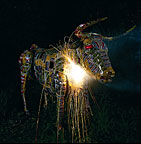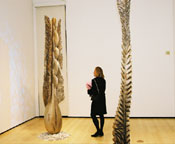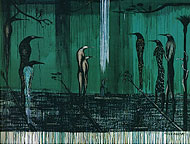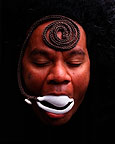Respiring Maori portraits assess their viewers with the persistent flicker of consciousness, solemn cameo prisoners in traditional dress, vital skin inhabited by the serpentine arcs and spikes of graphic facial tattoos. Interior life radiates from the gallery of eyes trained on absent vanishing points, glistening intensity clothed in feathered garments and armed with spears. Thinking nineteenth century photographs abruptly morph into a procession of startling images: Maori women and men in athletic warm-up suits, starched Victorian finery, modern nurse uniforms, tailored suits and fedoras, urban street gear, world war two uniforms. Jarring emotional time travel through a visceral picture album of individuals communally refusing the role of seated, passive subject.
 Lisa Reihana Native Portraits n.19897 |
Lisa Reihana’s video portraits of Maori, “Native Portraits n. 19897” (1997), revisit nineteenth century studio photographs of Maori from the Museum of New Zealand’s omnibus, infusing an inert past with the sentient blood of friends and family. Monitors pulse with intent, Reihana’s assertion “that our culture is still alive, that it feels vibrant”. But it is a venerable culture beset by pervasive westernization, riddled with pragmatic realities—not the bucolic Eden of modern collective longing, lost paradise of nurtured imagination. As potently manifested in the Asia Society’s exhibition, Paradise Now? Contemporary Art from the Pacific, it is the anti-paradise, deeply flawed protagonist marred by gnawing assaults and grievous injuries while heroically traversing a scarred landscape of brutalized nature and corroded species, cadaverous earth shorn of lush forests and festering with nickel mines, predatory Christianity, vanishing native traditions, and inevitable Diaspora.
Yet persistent shades of Gaugin’s Tahiti still masquerade as the veritable face of the Pacific Islands in mass consciousness; sultry Polynesian odalisques stretched naked across alabaster sand, heady rush of exoticism from bronze bodies dripping with lavender shadows, encircled by palm fronds and mangoes, wrapped in the scent of gardenias. Women, savage innocents, drink from springs like wild animals under canopies of heroic flora shooting towering scarlet plumes. Aesthetic as well as erotic plentitude defined Paul Gaugin’s paradise, cogently evoked in numerous canvases which still reign communally, more than a century after their creation, as the iconic vision of Pacific Island utopia.
Less celebrated, but arguably more psychologically revealing than his paintings, are Gaugin’s own writings of his life in Tahiti, Noa Noa, penned in 1893 as a first manuscript draft by a man enthroned in nirvana. Speaking of his thirteen year old wife, Tehamana, Gaugin writes: “The gold of Tehamana’s face flooded all about it, and the two of us would go naturally, simply, as in Paradise, to refresh ourselves in a near-by [sic] stream.” Several pages later, he deifies his child bride: “Naked like that, she seemed clothed in the orange-yellow garment of purity, the yellow mantle of Bhixu. A beautiful golden flower, whose Tahitian noa noa (a Tahitian word meaning ‘fragrant’) filled all with fragrance, and which I worshipped as an artist, as a man.”
Carnal women languishing in scented air, boundless azure dancing with briny life, muscular emerald jungles, skies quivering with birds under eternal sunshine—the antithesis of W.D. Hammond’s New Zealand, which spirals away from Gaugin’s Tahiti into Dante’s ninth circle. “Placemakers 1”, Hammond’s infernal 1996 painting, is a desolate vision of menacing, tainted water disgorging a cluster of anemic islands under corrosive, citrine sky incapable of holding breathable air. Moribund sentinels, anthropomorphic bird-men strongly reminiscent of Max Ernst’s surrealist hybrids, stand in trees and hang from leafless branches, their elongated bodies tattooed with portraits of wholesale extinction—annihilated flora and fauna, erased clouds and mountains, silenced waves and volcanoes. Past and present meet in this apocalyptic half life, where guardians of a vanished Arcadia preserve degraded nature that lives now only on the surface of their skin.
Surreptitious promenade into the abyss, “The Modern Dance (La Danse Moderne)”, a 1998 installation by New Caledonia native Denise Tiavouane, is deceptively benign—playing into tourist notions of the Pacific islands as animated postcard kitsch—without its substantial, wrenching back story. Three headless, limbless, grass-skirted dancers move as mechanistic automatons to sensual tribal music, their bamboo torsos anchored in a shallow box of soil hosting four diminutive, artificial fir trees; but this is merely an emaciated souvenir of double edged loss, the indigenous Kanak culture’s proud male dance tradition and New Caledonia’s once abundant native forests.
Nickel mining, representing almost 90% of the island’s exports and accounting for a staggering 30% of the world’s nickel output, has irreversibly damaged New Caledonia’s ecosystem, resulting in deforestation, erosion, and water pollution; opencast nickel mining produces tailings, tons of toxic sediment, which has been running off into the sea for years, causing irreparable damage to the world’s second largest coral reef (after the Great Barrier Reef in Australia), five thousand square miles of pristine, abundant marine life expelled from paradise—all within the brief span of one hundred years.
Robust plentitude reigned just a century ago, dazzling the European colonialists nestled, rapt, in its midst. “…in gardens to the north of Auckland I have stood under olive trees laden with berries, with orange trees, figs, and lemon trees in full bearing close at hand. Not far off a winding tidal creek was fringed with mangroves,” wrote the Hon. W.P. Reeves, Agent-General for New Zealand, in his paper contributed to the proceedings of the Royal Colonial Institute, May 12, 1896.
 Michel Tuffery Povi Tau Vaga |
Imperiled nature, an overriding theme of the exhibition, defines Michel Tuffery’s sculptures, robotic specters of life-sized animals rendered inorganic, hide and scales replaced by the very tins containing their flesh. Barracuda, yellow fin tuna, and bull exist only as flattened metal cans riveted together, ersatz creatures with hollow eyes that reflect nothing and expose only the depths of their fraudulent armatures. Brunswick Herring tins and recycled copper form the body of “O le Sao Sao Lapo’a/barracuda” (2000), refuse from the imported, canned fish starting to supplant fresh, local seafood in the Samoan diet, due to severe over fishing in the Pacific. Inescapable, is the bitter irony of an island population reduced to eating tinned fish.
What once was, serves to further underscore the dire reality of what is. Astonished by the bountifulness of Tahiti’s natural resources, painter Gaugin wrote, in 1893: “A few moments, and we caught a huge tunny…we fished till evening. …when the supply of the small fish used as bait was exhausted, the sun was setting the horizon ablaze with red. …Ten magnificent tunnies overloaded the pirogues.”
Canned corned beef and other westernized foods—hardly the tropical cornucopia of public imagination—now figure prominently in the Samoan diet, ushering in a host of chronic health problems linked to excess consumption of saturated fat, calories, and sodium. “In the urban areas of western Samoa, 60% of men and 75% of women are obese,” states the International Obesity Task Force (IOTF) in its press statement of August 25, 2003. “The link between obesity and type 2 diabetes is most manifest in this region, which has some of the highest levels of adult obesity.”
Empty behemoth vessel denying sustenance, Tuffery’s sculpture, “O le Povi Pusa Ma’ataua (Jewel Box of Bulls)” (1996), is mechanized beef devoid of nutrition. Despite the refined artistry of the bull’s riveted copper muzzle and elegantly laminated wooden horns, the massive animal—haunches meticulously wrought from Pacific Brand Corned Beef tins—has a haunting lack of physical substance, as if a single gust of wind could blow its standing carcass—and, metaphorically, an imperiled society—to pieces.
Human Diaspora, and the resulting untenability of retaining vital cultural traditions in myriad small island cultures, runs concurrent with threatened native Pacific Island animal populations in “Triple Shark” (1999), “Frigate Bird” (2000), and “Whale Boat” (1997), Ken Thaiday’s animatronic headdresses for the twenty-first century. Designed to sit atop the head of a dancer as ceremonial millinery, replete with moving parts operated by strings, the sculptures are disturbing amalgams of artifice and naturalism, rustic cyborgs melding keen observation of wildlife with naively robotic series of interconnected pulleys in a pantomime of blunted nature. Pervasive sadness inhabits the headdresses, which have the pathos of 100 A.D. Roman Egyptian funerary portraits, startling resurrections of the recently deceased endowed with a moment’s wavering consciousness.
Thaiday, born on the Torres Strait Islands but relocated to Cairns, Australia, conjures the animals of his childhood as mythic entities remembered from a dream by one far removed from the immediacy of their scent, blood, breath, and cries. Enduring nature, as exalted in the Maori proverb: Whatu ngarongaro he tangata, toitu he kainga (The people have disappeared—only the land remains), has been irrevocably impeded, with hominal exodus bearing a crown of fauna that lives only through the effort of a human hand pulling its strings, activating metal levers and hinges that control its every movement.
Stillness inhabits the landscape of Niue Island, its gorges, furrows, hollows and creases luminous against saturated bronze earth; serenity defines the colossal photograph of John Pule’s face, its ravines, canyons, pores and chasms mapping the nature of tranquility. A large, white cowrie shell fills the man’s mouth, extending past its corners to form a second pair of lips tied to a tightly coiled multiple braid which follows the contour of his visage, snaking across the hair line to coil in terminus on his forehead. “Savage Island Man with Pure” (2003) is Sofia Tekela-Smith’s portrait of her partner, fellow artist John Pule, a photograph of her handcrafted body ornaments worn by the true face of the Pacific Islands. Contrasting persistent historical stereotypes with the verity of indigenous authenticity, Tekela-Smith addresses perceptions of the barbarous, uncivilized wild man, enduring remnants of last century’s prolific writings by European colonialists.
In his 1896 paper contributed to the proceedings of the Royal Colonial Institute, Agent-General for New Zealand, Hon. W.P. Reeves, observed Maori disposition with an unusual syncretism of scientific scrutiny and poetic meditation: “The courage of the Maori, their intelligence, their look of manliness, the very ferocity of their long-relinquished habits, have attracted curiosity and attention. To me among the most interesting points with regard to them is the uncertainty of their origin and future fate.”
 John Ioane Fale Sa |
An essential facet of Maori philosophy is epitomized by one of their most popular sayings: Ka mate Kainga tahi, ka ora kainga rua. (When one place is untenable, have another to go to.) “A space for healing”, “Fale Sa” in Samoan, is artist John Ioane’s resplendent construct of a sacred space, a 1999 installation based on his most vivid childhood memories of Samoa—the ocean. Alchemically transforming air into water, Ioane metamorphosed two adjoining rooms into tangible liquid; one moves through a channel carved from ocean depths, feeling the weight of water with its ephemeral textures and intricate moods. Gossamer net of undulating light projects an implied sea, breathing becomes labored and hopelessly dry, as aqueous music embraces the slight human forms temporarily inhabiting this alternative realm. Three totemic forms painted the alien metallic gray of shark skin dominate the second chamber, towering from nests of whole and broken seashells—not the exotic elite of dramatic spines and brilliant tropical hues, but modest ocean refuse far removed from habitation, riddled with worm holes and shattered underfoot.
Even the trio of monoliths eschews anthropic associations, redolent only
of coral branches, sea fans, and ocean vegetation. Away from an imperfect
world, the notion of a sacred space offers human comfort precisely because
the human element—the clamor, strife, and poignant compromises of
life on land—is conspicuously, blissfully absent.

